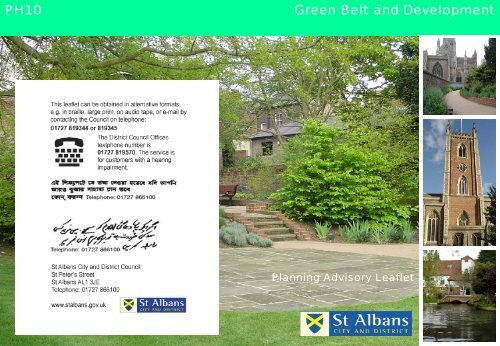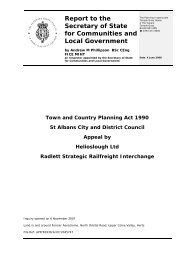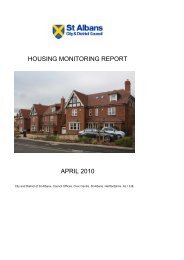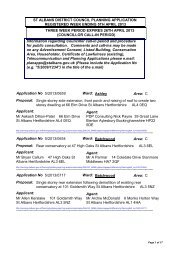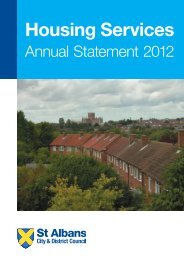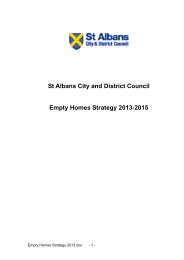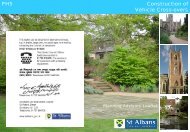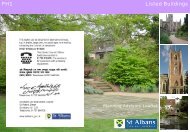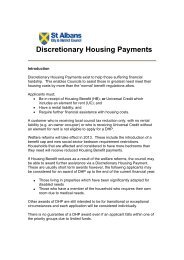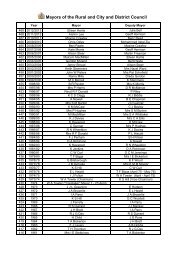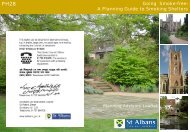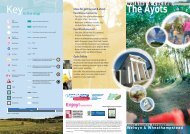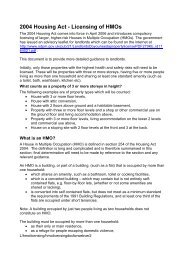Green Belt and Development - St Albans City & District Council
Green Belt and Development - St Albans City & District Council
Green Belt and Development - St Albans City & District Council
You also want an ePaper? Increase the reach of your titles
YUMPU automatically turns print PDFs into web optimized ePapers that Google loves.
PH10<br />
<strong>Green</strong> <strong>Belt</strong> <strong>and</strong> <strong>Development</strong><br />
Planning Advisory Leaflet
GREEN BELT AND DEVELOPMENT:<br />
WHAT IS PERMITTED<br />
<strong>Green</strong> <strong>Belt</strong>s are a major success of post-war town <strong>and</strong> country<br />
planning. This leaflet outlines their purpose.<br />
The history<br />
Back in the 19 th Century, when town planning was recognised as a<br />
means of dealing with the crowded <strong>and</strong> unhealthy living conditions<br />
in cities, Ebenezer Howard created the ‘garden city’. A general<br />
strategy developed, which envisaged city living areas as a series of<br />
communities that were clean, green <strong>and</strong> spacious, <strong>and</strong> separated<br />
by a ‘green backcloth’ of farml<strong>and</strong>, forest <strong>and</strong> parks. Welwyn<br />
Garden <strong>City</strong> <strong>and</strong> Letchworth came into being.<br />
The purpose of the <strong>Green</strong> <strong>Belt</strong><br />
<strong>Green</strong> <strong>Belt</strong>s have since been adapted to modern conditions. Their<br />
five main purposes are:<br />
to check the unrestricted sprawls of large built-up areas;<br />
to prevent neighbouring towns from merging into one another;<br />
to assist in safeguarding the countryside from encroachment;<br />
<br />
<br />
to preserve the setting <strong>and</strong> special character of historic towns;<br />
to assist in urban regeneration by encouraging the recycling of<br />
derelict <strong>and</strong> other urban l<strong>and</strong>.<br />
What <strong>Green</strong> <strong>Belt</strong>s mean to you<br />
Once <strong>Green</strong> <strong>Belt</strong>s have been defined, they have a positive role to<br />
play in fulfilling the following objectives:<br />
to provide opportunities for access to the countryside for the<br />
urban population;<br />
to provide opportunities for outdoor sport <strong>and</strong> recreation;<br />
to retain <strong>and</strong> enhance l<strong>and</strong>scapes near to where people live;<br />
to secure nature conservation;<br />
to retain l<strong>and</strong> in agricultural, forestry <strong>and</strong> related uses.<br />
<strong>Green</strong> <strong>Belt</strong>s today<br />
There are now 14 separate <strong>Green</strong> <strong>Belt</strong>s surrounding nearly all of<br />
Engl<strong>and</strong>’s major towns <strong>and</strong> cities. Where there is a potential for<br />
separate towns to merge into each other, <strong>Green</strong> <strong>Belt</strong>s protect their<br />
individuality <strong>and</strong> provide a breathing space. They cover 12% of<br />
Engl<strong>and</strong>, <strong>and</strong> by restricting development they affect what happens<br />
elsewhere. For example, development of new factories <strong>and</strong> offices<br />
may be redirected to the inner city areas where they are most<br />
needed.<br />
Is development prohibited in <strong>Green</strong> <strong>Belt</strong>s ?<br />
In the main, yes. Inside a <strong>Green</strong> <strong>Belt</strong>, approval should not be given,<br />
except in very special circumstances, for the construction of new<br />
buildings, or the change of use of existing buildings, for purposes<br />
other than agricultural <strong>and</strong> forestry, outdoor sport or other uses<br />
appropriate to the rural area. Any proposal should not have a<br />
material impact on the openness of the <strong>Green</strong> <strong>Belt</strong>.<br />
Other proposals for development are likely to be refused permission<br />
unless very special circumstances apply. For instance, some<br />
developments need to fulfil specific operational requirements, such<br />
as power stations, mining, etc. Others are in the national interest,<br />
such as prisons <strong>and</strong> military installations; these are the exceptions<br />
rather than the rule.<br />
There are also controls over the size of extensions allowed to<br />
dwellings in the <strong>Green</strong> <strong>Belt</strong> <strong>and</strong> restrictions on the use of<br />
replacement dwellings, including those within <strong>Green</strong> <strong>Belt</strong><br />
settlements.<br />
Are all <strong>Green</strong> <strong>Belt</strong>s the same?<br />
Yes, in principle, but not in detail. While National <strong>Green</strong> <strong>Belt</strong> policy<br />
applies to each of them, local circumstances must be taken into<br />
account. Policies limiting development vary according to local<br />
needs. This <strong>Council</strong>’s policies are set out in the <strong>St</strong> <strong>Albans</strong> <strong>District</strong><br />
Local Plan Review 1994, which is available for public inspection<br />
<strong>and</strong> on the <strong>Council</strong>’s website: www.stalbans.gov.uk.<br />
1<br />
2
Are <strong>Green</strong> <strong>Belt</strong> boundaries permanent?<br />
They are generally set for the foreseeable future but are not<br />
necessarily permanent. Changes to the boundaries respond to the<br />
needs, pressure <strong>and</strong> particularly the increasing mobility of urban<br />
populations. Inner <strong>Green</strong> <strong>Belt</strong> boundaries may change where the<br />
<strong>Council</strong> <strong>and</strong> Government are convinced that the re-use of derelict<br />
l<strong>and</strong> will not be sufficient to meet all the area’s needs, in particular<br />
the need for housing. Once the general extent of a <strong>Green</strong> <strong>Belt</strong> has<br />
been approved, it should be altered only in exceptional<br />
circumstances. A full public consultation on an amendment has to<br />
take place, usually as part of the Local <strong>Development</strong> Framework<br />
<strong>and</strong> <strong>Development</strong> Plan process.<br />
Finding out about your <strong>Green</strong> <strong>Belt</strong><br />
The whole of <strong>St</strong> <strong>Albans</strong> <strong>District</strong> lies within the <strong>Green</strong> <strong>Belt</strong> except the<br />
following:<br />
the <strong>City</strong> of <strong>St</strong> <strong>Albans</strong>;<br />
Harpenden <strong>and</strong> the larger settlements such as<br />
Wheathampstead, Redbourn, Park <strong>St</strong>reet, Bricket Wood,<br />
Chiswell <strong>Green</strong> <strong>and</strong> London Colney;<br />
some industrial/warehousing estates such as Buncefield <strong>and</strong><br />
North-East Hemel Hempstead.<br />
The following smaller villages are located in the <strong>Green</strong> <strong>Belt</strong> <strong>and</strong> are<br />
known as <strong>Green</strong> <strong>Belt</strong> settlements:<br />
Annables, Kinsbourne <strong>Green</strong>;<br />
Colney Heath;<br />
S<strong>and</strong>ridge;<br />
Folly Fields;<br />
Gustard Wood;<br />
Lea Valley Estate;<br />
Radlett Road, Frogmore;<br />
Sleapshyde;<br />
Smallford.<br />
Further information<br />
This advisory leaflet is intended to be a helpful <strong>and</strong> useful source of<br />
information <strong>and</strong> not binding on any party. The <strong>Council</strong> offers no<br />
guarantee or warranties concerning the accuracy of the information<br />
supplied.<br />
For more information about the contents of this leaflet contact:<br />
The Planning Department<br />
<strong>St</strong> <strong>Albans</strong> <strong>City</strong> <strong>and</strong> <strong>District</strong> <strong>Council</strong><br />
<strong>St</strong> Peter’s <strong>St</strong>reet<br />
<strong>St</strong> <strong>Albans</strong>, Hertfordshire AL1 3JE<br />
Telephone: 01727 819344 or 819345<br />
Email: planning@stalbans.gov.uk<br />
Website: www.stalbans.gov.uk<br />
Produced by <strong>St</strong> <strong>Albans</strong> <strong>City</strong> <strong>and</strong> <strong>District</strong> <strong>Council</strong><br />
Revised June 2007. PH10(a)<br />
3<br />
4


